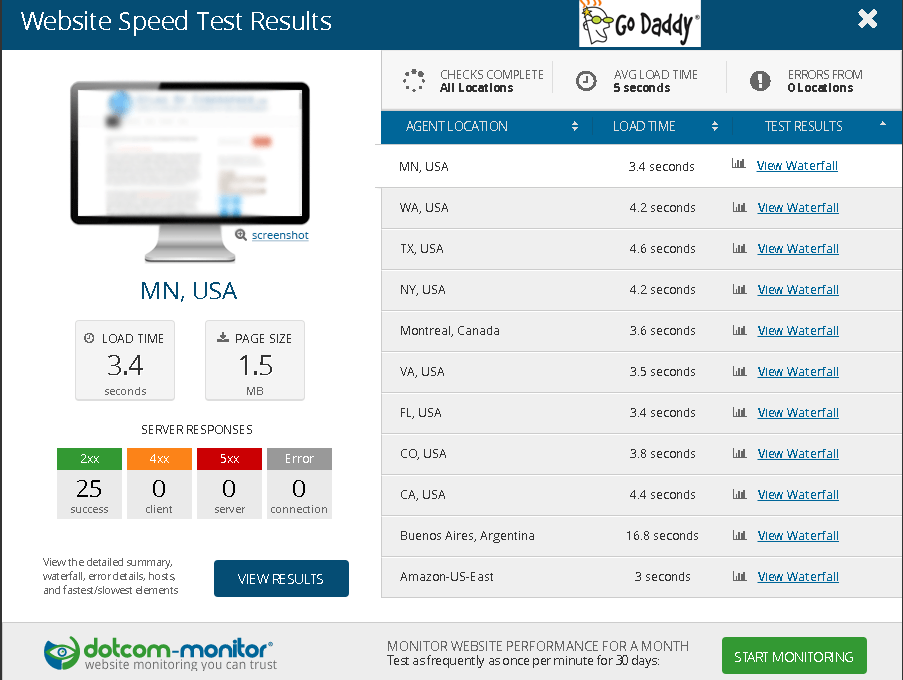Bluehost vs GoDaddy- Who Comes on Top in 2021?
If you’ve ended up here on this particular page, you’re probably comparing Bluehost and GoDaddy to determine which host is the best. It’s also likely that you’ve stumbled across other review sites that don’t provide much (if any) objective information and just try to push you into clicking on a signup button so they can earn a commission. Let me tell you—that’s not something that you’ll find here.
WebHostingBuddy was created to be a truly informative site that provides real and honest web hosting reviews. On this page, you’ll find that Bluehost and GoDaddy are objectively and subjectively compared using a variety of metrics to help you figure out once and for all which host might be the best fit for your needs.
Taking things one step further, we’ve hosted two WordPress sites—one on Bluehost and one on GoDaddy for a whole year and ran a variety of tests on them in order to gather a large amount of data. On top of that, you’ll have the chance to read our expert opinion both on Bluehost vs. GoDaddy (we’ve been building websites professionally for over a decade and a half, so we know our stuff!).
Just to be clear: if you do happen to buy hosting from one or more of the various links on this particular page, we may (this is not guaranteed) get paid a commission. This doesn’t, in any way, affect our reviews or information, as there are many hosts that pay high commissions that we refuse to recommend because they essentially suck so bad. You can read more on this site about the hosts we don’t like. That said, if you would like to purchase from a link on this page, it helps us to keep this site going and provide more in-depth reviews!
Now that we’ve covered some of the initial information, let’s look at Bluehost compared to GoDaddy and see how they match up against each other.
GoDaddy vs Bluehost: Evaluation and Comparison Metrics
There are so many things to consider when comparing web hosts, it’s enough to make anyone dizzy. To keep things simple, there are 5 broad categories we typically like to look at in order to see how one web host stacks up against another. You’ll see these metrics in other comparisons on this site as we really believe that they’re the best snapshot of a web host’s quality and value.
The metrics we use are:
- Speed & Web Performance
- Reliability (Uptime and Downtime)
- Quality of Support
- UI/UX and Ease of Use
- Pricing, Hosting Features, and Plans
The remainder of this page will break down both hosts in each category using various testing data to help you understand how they compare.
Speed and Web Performance: Bluehost vs GoDaddy
We typically put the “Speed and Web Performance” category first when comparing web hosts because it’s truly one of the best “measuring sticks.” It really separates a good hosting company from a bad web hosting company. If a host is slacking on managing their infrastructure and resources it will usually be obvious right away in the speed (or lack thereof) of their servers.
Speed is also an important part of user-satisfaction for a website because in the current age of broadband and LTE, website visitors don’t have much patience for sites that load slowly or freeze. There’s a lot of data to suggest that 3 seconds is the threshold for user attention—when a web page takes longer than that to load, it often results in users bouncing from that site.
In order to put things into perspective, we went ahead and put Bluehost and GoDaddy against one another in order to determine which host had the fastest load time. To accomplish this, we ran a web page speed test on two different WordPress websites—one hosted on Bluehost, and the competing site hosted with GoDaddy. The speed test we used here (and our overall favorite) is the test from Dotcom-Monitor, located at Dotcom-Tools.com. We like it because they allow you to run a single test and check from multiple locations around the world. To keep things simple for this test, we used their “American” network, which includes both North and South America. If you take a moment to review the screen shots below, you’ll see the test times summarized in the charts.
You’ll notice above that Bluehost’s fastest load time was just under 2 seconds (1.4 to be exact) and their average load time was 3.3 seconds, which is right at the user-bounce threshold. In comparison, if you look at the image below, the best load time that GoDaddy could muster was 3.4 seconds and their worst load time was 16.8 seconds from the South American data center in Argentina.
Looking at the averages, you can see that Bluehost was faster across the board and had an average load time that nearly matched GoDaddy’s best effort, which doesn’t look all that good for GoDaddy.
The champion for speed and performance: Bluehost.
While we wouldn’t say that GoDaddy had a bad showing per se, they just didn’t seem to have the same snappiness to their server response times that Bluehost did. We can also say that this echos our personal experience with the hosts. Based on years of hosting websites professionally and personally, we’ve found that Bluehost is relatively superior to GoDaddy from our perspective in terms of web performance and speed.
VISIT BLUEHOST
Bluehost and GoDaddy—Reliability (Uptime and Downtime)
Uptime and downtime are two very important metrics with respect to hosting, and the reason for this is simple—if your web server is down, no one can access your site as your site will be down too. This can be very bad if you’re running a business and can lead to lost revenue and lost customers. If you’re a blogger, writer, or website owner, it can be very damaging to your reputation and can be especially problematic if you have some website content that was about to go viral. Imagine the frustration that your readers would have trying to access a great piece of content only to find that your server is offline. So, it should be obvious that your server being online and not down is very important.Most hosts have a Service Level Agreement (also known as an SLA) which explains their policies regarding uptime and downtime periods. The industry standard for uptime is generally 99.9% or a very similar number. GoDaddy’s uptime SLA number is 99.9%, however, at the time of writing, they will only reimburse for the period that the server was down, not a full credit for a month of service. Some hosts, like HostGator will actually give a free month in the event that the uptime percentage dips below the level specified in their SLA. Bluehost, at the time of writing, does not have a specified uptime percentage and refunds would have to be requested on a case-by-case basis, which in our opinion isn’t the best policy either. They do, however, offer no-fee refunds on the unused portion of your hosting cost in the event that you choose to terminate the account for hosting downtime.
In order to see who had the best uptime between Bluehost and GoDaddy, we enabled professional monitoring on two self-hosted WordPress websites (one hosted on Bluehost, and one hosted on GoDaddy) for 12 straight months. We used Dotcom-Monitor for these checks and their ServerView platform. We had their system ping each site for an uptime/downtime check at 3 hour intervals. Take a look at the images below to see the uptime reports.
As you can see, after 12 months, Bluehost had 99.81% uptime for the year, which is fairly respectable. It’s really close to the proverbial 99.9% industry standard, although they don’t specifically adhere to that or give a specific percentage in their SLA.
GoDaddy came in at 98.5% for the year, which might not sound like much less but it’s below the standard specified for a month of service in their SLA, and it’s also below the industry standard of 99.9%.
With that said, Bluehost is the clear winner in the reliability category.
While GoDaddy didn’t necessarily have bad uptime numbers, they did seem to fall a bit below the golden standard of 99.9%. Also, their SLA policy kind of stinks in our opinion because they only reimburse for the period in which the site is down. While Bluehost doesn’t specifically spell out a refund schedule for uptime/downtime, we have had success in getting a refund for more than the time a site was down after talking to customer service. While there’s no guarantee that they’d do this regularly, we think that the sheer numbers in this case point to Bluehost having slightly better reliability.
Quality of Support—Bluehost Compared With GoDaddy
Support is one of those subjects where opinions vary quite a bit. While one individual might have had a great experience with a particular host, a different individual might have had a terrible experience with that same hosting company. Sometimes customers can be upset when it really isn’t justified, and in other cases a bad review of a particular host really is justified. It can be hard to know from one person to the next whether or not a host is at fault for something that happened or whether a person just had a single bad experience.
We’ve been building websites professionally for over a decade, and because of that we’ve had multiple experiences with most mainstream hosting companies in both business and personal capacities. So in this section, you’ll get our opinion, but you’ll also get some facts about the type of support offered by each company at the time of writing.
Let’s take a look at Bluehost first. To begin with, they offer all forms of support—phone, chat, ticket, email, etc. and their support is offered 24/7/365, which is a must for any web hosting company. We’ve seen some companies that have limited hours for support and this is really inexcusable for a modern web hosting company. We have noticed that the quality of Bluehost’s support has seem to go down a bit in the last 6 months or so in terms of the wait times. However, this may have just been our subjective experience.
One thing we really like about GoDaddy is that they have great phone support. It’s not hard to get a person from the US on the telephone, but they definitely gear the support toward their domain business. It’s harder to get a knowledgeable person for web hosting support, which may leave some people searching for GoDaddy alternatives. Also, our experience with their chat has been pretty bad…it’s been something that really is really lacking on their end. One of the most frustrating things about their chat is that we’ve noticed that it takes a really long time for the chat technician to respond in between questions/exchanges.
In our opinion, the winner of the support category is clearly Bluehost.
While GoDaddy does have excellent support for domains, their hosting support is lacking and we’ve had trouble getting skilled technicians on the phone or in chat who can help or truly understand the problem at hand. While this can also be an issue with Bluehost, because they are primarily a hosting company and not a domain registrar, we’ve found their hosting support to be much better than GoDaddy.
UI/UX and Ease of Use: Bluehost vs GoDaddy
This is an interesting comparison, because GoDaddy has a relatively slick interface but so does Bluehost. If we were talking about the domain interface, we’d have to give this one to GoDaddy easily; their domain interface rocks and it’s very easy to navigate. However, because they’re not a hosting company first and foremost, their hosting interface leaves a bit to be desired. They have some odd ways of integrating cPanel and it’s a bit clunky overall in our opinion.
Bluehost, however, has an excellent interface that is very “newbie-friendly” when it comes to being intuitive and easy-to-use. We’ve had people with relatively little experience using a web hosting panel do fairly well when trying to navigate the Bluehost backend. Most big hosts have their own custom cPanel layouts and features, but Bluehost does one of the best and cleanest jobs that we’ve seen.
They make it extremely easy install WordPress on your hosting account, get at all of the databases, etc. and they also have pretty good support/wiki section where you can look up answers to common questions. Their support staff also seems to understand the backend very well and they do a good job of communicating this via chat when questions are asked.
Therefore, the winner in terms of UI/UX and ease-of-use is definitely Bluehost.
It’s not that GoDaddy has a bad interface, as they use cPanel, but it definitely leaves something to be desired and it’s obvious that that hosting isn’t the focus of their business. Bluehost really shines here and makes it relatively easy to beat GoDaddy.
GoDaddy versus Bluehost: Pricing, Hosting Features, and Plans
Pricing is an interesting thing in the world of web hosting because there are so many coupons and things that can alter the prices. On top of that, the initial prices are always better than the renewal prices, similar to the way that cable TV is priced. Hosts are somewhat notorious for offering low introductory rates and then jacking up the prices quite a bit during renewal time, so it’s important when signing up for any web host to understand what your renewal prices will be
That said, Bluehost and GoDaddy are both competitive in terms of their pricing for web hosting. Bluehost’s lowest pricing is about $2.95/month for their cheapest shared hosting plan with our exclusive Bluehost coupon.
GoDaddy plays the same game that almost all web hosts do when it comes to pricing and their lowest priced shared hosting is $3.99/month if you sign up for multiple months (36 months to be exact). Many people aren’t interested in signing up for so many years at a time, so it is a nice tactic to generate sales, but not always practical for most people looking to test out a host—in that situation, 12 months is a bit more common in terms of a time length.
In terms of how the cheapest plans stack up on each host, Bluehost offers 1 website, 50 GB of storage, unmetered bandwidth, 1 domain, and 5 email accounts. GoDaddy offers 50 GB more bandwidth, but 95 more email address (100 vs 5 with Bluehost). When you step up to the next plan (Bluehost’s $4.95/month plan and GoDaddy’s $4.99/month plan) nearly everything is unlimited. GoDaddy does limit the email addresses to 500 where Bluehost offers unlimited email addresses. As you’re probably beginning to see, shared hosting is so commoditized that most things are really equal. Although I’d say if you’re looking for nonprofit hosting, Bluehost might be your best bet in the long run in terms of price. That factor aside, they’re basically equal on pricing alone (which shouldn’t be the biggest factor when choosing a host as support and reliability are much more important).
That’s why in the pricing category, it’s a tie.
Because Bluehost and GoDaddy have pricing that’s so similar, it’s really best to choose one or the other based on some of the other categories as there’s really not enough distinction in terms of pricing.
And the overall winner is…
Why is Bluehost the better of the two in our opinion? Well, first of all they have better speed ratings and better uptime based on totally objective factors, not our opinion at all. Those are two of the absolute most important factors when choosing a web host.
In terms of customer support and ease-of-use, Bluehost wins again. The only area where they are really equal is in pricing, but in all other areas, Bluehost really outshines GoDaddy in almost all ways. GoDaddy isn’t a bad choice, we just honestly believe it boils down to the fact that GoDaddy is a domain registrar first and a web host second, and this really shows in the quality of their support and the way that they manage their servers. Bluehost does offer domain registration as well, but we’d recommend GoDaddy for that hands down. That said, if you’re trying to decide between Bluehost and GoDaddy for web hosting, it’s our strong opinion that Bluehost is the way to go.
VISIT BLUEHOST












Post a Comment
Post a Comment